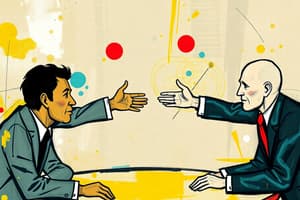Podcast
Questions and Answers
Explain the process of conflict according to the text.
Explain the process of conflict according to the text.
Conflict is described as a process involving a series of actions, reactions, and interactions between parties over time.
What is the core of conflict, according to the text?
What is the core of conflict, according to the text?
The core of conflict lies in the perception that something of importance to one party is under threat or being harmed, such as money, territory, values, beliefs, or relationships.
How does conflict arise, as mentioned in the text?
How does conflict arise, as mentioned in the text?
Conflict arises from differences in perception, where one party interprets a situation in a way that differs from another party. It involves at least two parties with distinct interests or perspectives.
What is the Traditional View of Conflict, as per the text?
What is the Traditional View of Conflict, as per the text?
What are the transitions in Conflict Thought mentioned in the text?
What are the transitions in Conflict Thought mentioned in the text?
Flashcards are hidden until you start studying
Study Notes
Understanding Conflict
- The core of conflict is the pursuit of incompatible goals, which leads to interference from one party with the goal attainment of the other party.
Arising of Conflict
- Conflict arises when two or more parties have competing interests, values, or goals, and one party perceives the other as blocking their goal attainment.
Traditional View of Conflict
- The Traditional View sees conflict as a negative and dysfunctional element that disrupts group functionality, undermines performance, and destroys relationships.
Transitions in Conflict Thought
- The text mentions three transitions in Conflict Thought:
- First transition: From the Traditional View to the Human Relations View, which considers conflict as a natural and inevitable aspect of human interaction.
- Second transition: From the Human Relations View to the Interactionist View, which emphasizes the functional aspects of conflict, such as improved communication and group cohesion.
- Third transition: From the Interactionist View to the Collaborative View, which focuses on the interdependence of parties and the potential for mutual benefits through conflict resolution.
Studying That Suits You
Use AI to generate personalized quizzes and flashcards to suit your learning preferences.




